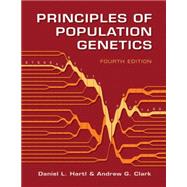Principles of Population Genetics

Principles of Population Genetics
- ISBN 13:
9780878933082
- ISBN 10:
0878933085
- Edition: 4th
- Format: Hardcover
- Copyright: 12/31/2006
- Publisher: Sinauer Associates is an imprint of Oxford University Press
.svg) Rent
From $102.63
Rent
From $102.63
List Price $191.98 Save
| TERM | PRICE | DUE |
|---|---|---|



List Price $191.98 Save $51.68
Usually Ships in 24-48 Hours
We Buy This Book Back!
Free Shipping On Every Order
List Price $191.98 Save $1.92
Usually Ships in 3-5 Business Days
We Buy This Book Back!
Free Shipping On Every Order
Note: Supplemental materials are not guaranteed with Rental or Used book purchases.
Extend or Purchase Your Rental at Any Time
Need to keep your rental past your due date? At any time before your due date you can extend or purchase your rental through your account.
Summary
Chapter 1 presents the fundamental observations and means for quantifying amounts and structure of genetic variation in natural populations. Chapter 2 gives a detailed examination of the implications of random mating for one locus and multiple loci and establishes the basic principles for thinking about mathematical models of variation. Chapter 3 presents the classic Wright-Fisher model as well as the coalescent approaches to random genetic drift. Chapter 4 adds mutation to models of drift and lays down the foundations for the neutral theory of molecular evolution. Natural selection in its many guises gets a thorough coverage in Chapter 5. Chapter 6 examines population subdivision and its consequences for the distribution of genetic variation among subpopulations, including the hierarchical F statistics used in estimating these effects. Molecular population genetics, including applications of coalescent theory, is the subject of Chapter 7. Evolutionary quantitative genetics is covered in Chapter 8, including an up-to-date treatment of the use of molecular markers for mapping and assisting in selection of quantitative characters. Chapter 9 is a new addition and covers the exciting field of population genomics, or the analysis of population genetic principles at a genome-wide scale. Finally, because of the explosion in genome-wide polymorphism data in humans and the realization that many problems in empirical population genetics need to be tuned to special, non-equilibrium circumstances of human populations, the authors devote Chapter 10 to human population genetics.
Applications of principles discussed in the text are illustrated with numerous examples of worked problems, using actual data. Many vital Web links are scattered throughout the text to connect the material to up-to-the-minute progress in this exciting field. Each chapter ends with a complete summary and offers several problems for solution, to reinforce and further develop the concepts.







